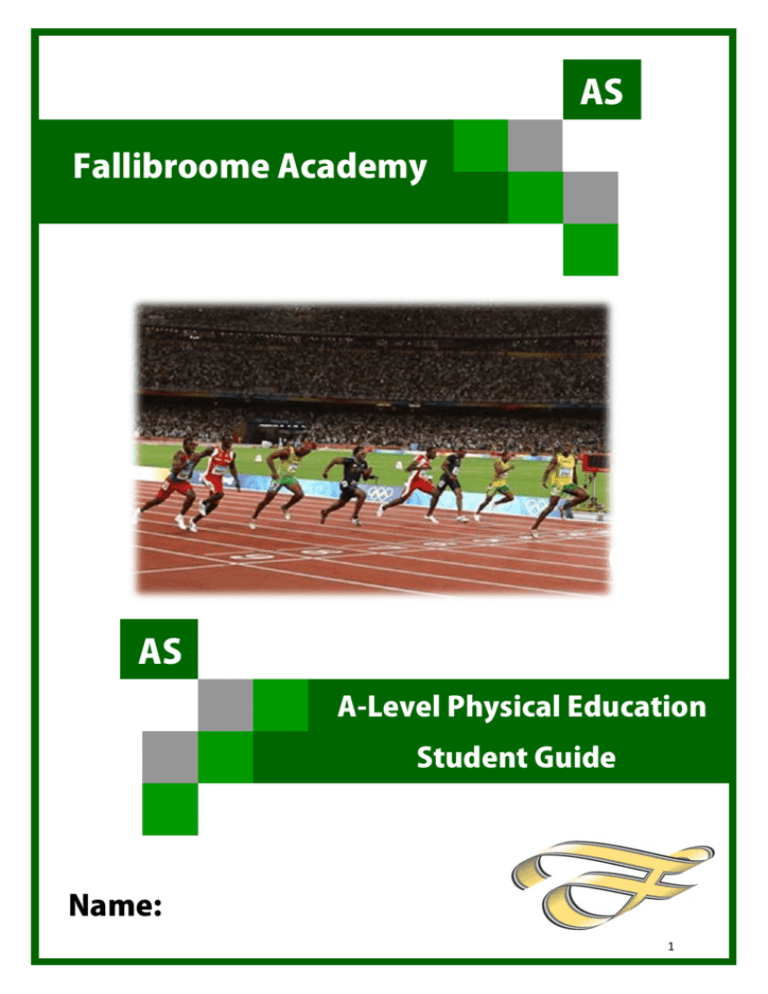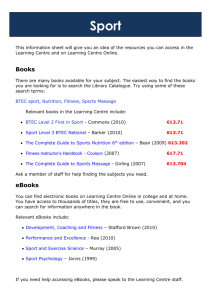AS Level Study Guide - Fallibroome Academy
advertisement

AS Fallibroome Academy AS A-Level Physical Education Student Guide Name: 1 Before we start AS Why did you choose this subject? What are your expectations of the subject? What s your target Grade? For PHED1 & PHED2? Is it realistic? What do you need to get to achieve it (refer to UMS boundaries)? How do you learn best? What will you need to do differently from year 11? 2 How do you plan to gain extra knowledge, skills and experience to supplement what you will learn in lessons? ? 3 AS Study Guide - Contents Page The Bigger Picture 5 The Specification 6 A2 Grading System 10 Monitoring Your Progress 12 Directive Terms 16 Websites 17 Glossary 20 4 AS AS PE ‒ The Bigger Picture At AS level, you will develop the knowledge and skills to help understand the opportunities for and effects of leading a healthy and active lifestyle. You will be given the opportunity to build on your experience and improve your personal skills/techniques across a variety of roles and in a sport of your choice to improve performance. At AS level you will complete two units: Unit 1: Opportunities for and the effects of Unit 2: Analysis and evaluation of physical leading a healthy and active lifestyle activity as performer and/or in an adopted role/s The physiological effects of adopting a healthy lifestyle Execution of skills/techniques in two roles (performer, official or leader/coach) in a chosen physical activity The short-term effect of exercise/performance and the long-term effects of training Analysis of own performance Application of theoretical knowledge to achieve effective performance Analysis of movement across a range of sporting actions Acquisition of skills and the impact of psychological factors on performance. Opportunities for physical activity, benefits to the individual and society and the potential barriers faced by minority groups. Assessment in PHED 1 Assessment in PHED 2 2 hour written paper. Section A: Questions on applied physiology, skill acquisition and opportunities for participation. Section B: Examines the application of theoretical knowledge to a practical situation. 60% of total AS level marks. Internal practical assessment. External moderation. 40% of total AS level marks. 20% of total A level marks. 40% of total A-Level marks. 5 AS PE ‒ The Specification AS Unit 1: Opportunities for and the effects of leading a healthy and active lifestyle 1. Applied Exercise Physiology Health, exercise and fitness Definitions of health and fitness and the relationship between them Consideration of the problems associated with trying to define health and fitness Components of health-related fitness; stamina, muscular endurance, strength, speed, power, flexibility Components of skill-related fitness . reaction time, agility, co-ordination and balance Effect of lifestyle choices on health and fitness. Nutrition Seven classes of food and their exercise-related function . fats, proteins, carbohydrates, vitamins, fibre, minerals and water The need for a balanced diet and the energy balance of food Performer’s use of nutritional information based on their activity, difference in diet composition between endurance athletes and power athletes Definitions of obesity and the limitations in trying to define it Percentage body fat/body composition and Body Mass Index (BMI) as measures of nutritional suitability. Pulmonary Function Mechanics of breathing Lung volumes and capacities and interpretations from spirometer readings regarding rest and exercise Gas exchange systems at alveoli and muscles, Principles of diffusion, partial pressures, difference in oxygen and carbon dioxide content between alveolar air and pulmonary blood Role of blood carbon dioxide in changing breathing rate. Transport of Blood Gases Roles of haemoglobin and myoglobin Transport of oxygen; Bohr shift Pulmonary and systematic circulation related to the various blood vessels (arteries/arterioles/capillaries/venules and veins) Generation of blood pressures/velocities Venous return mechanism Redistribution of blood/vascular shunting Arterio - venous oxygen difference (A-VO2 diff). 6 Cardiac Function Cardiac cycle Cardiac output, stroke volume and heart rate and the relationship between them. Heart rate range in response to exercise; hormonal and nervous effects on heart rate; Role of blood carbon dioxide in changing heart rate Cardiac hypertrophy leading to bradycardia/athlete’s heart Starling’s law of the heart Cardio-vascular drift. Analysis of movement in specified sporting actions (including planes and axes). Shoulder and elbow action in: o o o Hip, knee and ankle action in: o o o o Push-ups Over-arm throwing Forehand racket strokes Running Kicking Jumping Squats Types of joint, articulating bones, joint actions, main agonists and antagonists, types of muscle contraction: isotonic (concentric and eccentric) and isometric related to the above sporting actions. Levers 2. Three classes of levers and examples of their use in the body related to the above specified sporting actions. Relationship of levers to effective performance - mechanical advantages and disadvantages and range and speed of movement. Skill Acquisition Skill Acquisition Characteristics and definitions of skill Difference between motor and perceptual abilities Difference between skill and ability Types of skill - cognitive, perceptual and psychomotor Classification of skill, use of skill continua (open . closed, discrete . serial . continuous, gross, fine, self paced . externally paced). Information Processing Input - senses, receptors, proprioception, perception, selective attention Memory - functions and characteristics of short-term sensory store, short-term memory and long-term memory; strategies to improve memory, chunking, chaining, mental rehearsal and practice Decision making - reaction time, simple reaction time, choice reaction time, response time, movement time and the relationship between them Anticipation temporal and spatial 7 Factors affecting reaction time, Hick.s law, psychological refractory period, single channel hypothesis Motor programmes and sub routines Factors affecting the efficiency of the components of the information processing system and strategies for improvement Learning and Performance 3. Learning - stages of learning, use of guidance, how feedback differs between the different stages of learning Learning plateaus . causes and solutions Motivation - intrinsic, extrinsic, tangible and intangible Learning theories - operant conditioning, positive and negative reinforcement and punishment Cognitive/insight theories Bandura’s observational model of learning, social learning theory Motor learning .Schmidt’s schema theory (recall, recognition, initial conditions, response specifications, sensory consequences, response outcomes) Transfer of learning (positive, negative, zero, bilateral, proactive and retroactive) Impact of practice on improving learning Goal setting - benefits and types, principles of effective goal setting. Opportunities for participation Concepts and Definitions The characteristics and objectives of o Play o Physical education o Leisure and recreation o Active leisure o Outdoor and adventurous activities o Sport The relationships between these concepts and compare and contrast one concept with another The benefits of play, physical education, active leisure, outdoor and adventurous activities and sport to the individual and to society. Leisure Provision The characteristics and goals of the public; private and voluntary sectors The advantages and disadvantages of the public; private and voluntary sector provision The concept of best value in relation to public sector provision. Current Provision ‒ National Curriculum The historical, social and cultural factors contributing towards the development of the current provision of Physical Education (including the influence of the English Public Schools on the emergence of rational recreation (including games) and the concept of fair play.) How the development of physical activity within state elementary schools from the early 20th century from the concepts of military drill to post World War II provision and the emphasis on movement have helped increase participation 8 The characteristics of each of the Key Stages of the National Curriculum for Physical Education and the relevance of each in relation to increasing opportunity for participation The factors influencing provision in schools and the impact this has on pupils experiences The effects of developing school club links Initiatives such as Physical Education School Sport and Club Link Strategy (PESSCLS), School Sports Co-ordinator, Sports Colleges, Active Sports, Sports Leaders UK, the TOPS programme, Whole Sport plans designed to encourage the development of school club links and explain the potential benefits to the government (individuals or community) The role of national governing bodies, Sport England and Youth Sports Trust in increasing participation. Barriers to Participation & Equal Opportunities The terms equal opportunity, discrimination, stereotyping, inclusiveness and prejudice and give possible examples of each in sport The barriers to participation and possible solutions to overcome them for the following target groups: o Disability o Socio-economic class o Ethnic group o Gender o The solutions to overcome discrimination in sport to raise participation. Section B (Assessed by an Extended Question) Applied Exercise physiology in practical situations Principles of training - concepts of specificity, progression, over-training, overload, reversibility and tedium, FITT principles Calculating working intensities for optimal gains through heart rate and Borg scale, weights one rep max Fitness testing - reasons for testing, principles of maximal and sub-maximal tests, limitations of testing, specific test protocols, issues relating to validity and reliability. Physiological and psychological value of a warm-up and cool-down. Types of stretching exercises, active, passive, static and ballistic. Principles of safe practice Training methods - continuous, intermittent, circuit, weights, plyometrics and mobility training. Explanation of the principles of each method, specific examples, advantages and disadvantages. Skill acquisition in practical situations Factors to consider when developing skill and planning training/coaching sessions Teaching styles - command, reciprocal, discovery and problem solving Methods of presenting practice - whole, progressive part and whole-part-whole. Types of practice - massed, distributed, variable and mental practice. Methods of guidance - verbal, visual, manual and mechanical Feedback - types of feedback, Knowledge of Performance, Knowledge of Results, terminal, concurrent, delayed, positive and negative, intrinsic, extrinsic. 9 Exam Tip ‒ 12 Mark Questions AS PE - Grading System AS Extended questions have been introduced to differentiate between students and offer a stretch and challenge element. You need to familiarise yourself with the band descriptors below to ensure you are aware of what is required for your answers to access the top band range. A- Level Physical Education UMS Grade Boundaries Section B 12 Mark Question Band Descriptors 10 PHED 2 - Practical Assessment As early as possible you need to access the grading criteria for your sports/roles, understand what is required of you and work to improve your performance. Skills in isolation and in modified practices in category 1 and 3 activities are marked as 5 marks for each core skill. In category 2 activities, each event/stroke is marked out of 15. For the conditioned event, each of the 5 core skills should be marked out of 11 AS Monitoring Your Progress AS Physical Education Assessments Specification Area Assessment Mark % Grade Comment 12 AS Physical Education Assessments Specification Area Assessment Mark % Grade Comment 13 AS Physical Education Assessments Specification Area Assessment Mark % Grade Comment 14 AS Physical Education Assessments Specification Area Assessment Mark % Grade Comment 15 Directive Terms AS Directive Term Meaning/Requirement Name/ What is the name of....? This usually requires a technical term or its equivalent. Answers to this type of question normally involve no more than one or two words. A number of features or points, each often no more than a single word, with no further elaboration or detail required. “Define” requires a statement giving the meaning of a particular term. “What do you understand by the term....?” is used more frequently as it emphasises that a formal definition as such is not required. Use of qualitative or quantitative information to show understanding of a statement, or of a relationship between factors. This creates major difficulties for many students. A reason, justification, or interpretation must be given, not a description. The term “Describe” answers the question “What?”; the term “Explain” answers the question “Why”. Thus, “Explain a curve on a graph” requires reasons for any change of direction, or pattern that is evident. Linking of cause/problem and effect/solution. Marks awarded only if linkage is made. “Suggest” is used when it is not possible to give the answer directly from the facts that form part of the subject material detailed in the specification. The answer should be based on the general understanding rather than on recall of learnt material. It also indicates that there may be a number of correct alternatives. Presentation of both sides of an argument, seeking an opinion based on knowledge and analysis with a justified conclusion. Answers to questions involving these phrases must follow the instructions. Marks are always awarded for appropriate references to the information provided. General answers, however comprehensive, will not gain maximum credit. A properly labelled drawing is required. Outline of the main features “State” falls short of describing and amounts to no more than making bullet points. Clear statement of why one condition is better than another. Would normally need justification and/or qualification relevant to question. Common agreed factors for a situation, structure or process. A comparison between two states given in the question. Students should be precise and not be tempted to wander here. Theoretical concept underpinning a practical example. List Define/ What do you understand by the term....? Describe Explain Identify.... and explain Suggest Discuss Give the evidence for ..../ Using examples from... Draw Sketch State Advantage Characteristics Differences Principle 16 Further Research - Websites AS Sports Organisations Web Site Addresses British Council http://www.britishcouncil.org British Olympic Association http://www.olympics.org.uk/ Department of Culture, Media and Sport http://www.culture.gov.uk Disability Sport England http://www.disabilitysport.org.uk English Institute of Sport http://www.eis2win.org.uk Institute of Sport Sponsorship http://www.sports-sponsorship.co.uk/ International Olympic Committee http://www.olympic.org/ International Paralympic Committee http://www.paralympic.org/ Sports Coach UK http://www.sportscoachuk.org.uk Sport England http://www.sportengland.org UK Sport http://uksport.gov.uk Women’s Sport Foundation http://www.wsf.org.uk/ Youth Sports Trust http://www.youthsporttrust.org Information Organisations 1st4Sport http://www.1st4sport.com/ Governing Bodies http://www.sportsearch.org.uk/governing_bodies/ngbs/index.html Gatorade Sport Science Lab www.gisiweb.com Human Biology page www.bioanim.com Inner Body http://www.innerbody.com Lucozade Sports Academy www.thelssa.com/lssa/main.asp National Library of Medicine www.ncbi.nlm.nih.gov/entrez/query.fcgi Peak Performance http://www.pponline.co.uk Psychology Lab http://www.geocities.com/lazaridous/ Schoolzone http://www.schoolzone.co.uk/ 17 Sport Injury Journals http://www.physsportsmed.com/ Sports Science Information www.exploratorium.edu/sports Statistics Information http://www.robertniles.com/stats/ Training Programmes/Principles http://www.brianmac.demon.co.uk/ UK Sport http://www.uksport.gov.uk World Sport http://www.worldsport.com/ws/ Specialist websites for individual sections Nutrition www.nutrition.org.uk Healthy living www.bbc.co.uk/health/healthy_living/nutrition Food www.netdoctor.co.uk/focus/nutrition Physiology,fitness, training www.brianmac.demon.co.uk Exercise physiology home.hia.no/~stephens/exphys.htm Physiology www.anatomy.tv Sport science www.topendsports.com Fitness testing and training www.netfit.co.uk Fitness www.fitness-training.net/introduction Fitness testing and training www.topendsports.com Anatomy, fitness and training www.exrx.net Lung function www.estrellamountain.edu/faculty/farabee/biobk/BioBookRESPSYS.html Lung function www.breath2000.org/physiology.html Transport of blood gases www.chemsoc.org/networks/learnnet/cfb/transport.htm Transport of blood gases cal.man.ac.uk/student_projects/2001/MNQC7NDS/index.html Pulmonary and systemic circulations en.wikipedia.org/wiki/Systemic_circulation Circulation www.ivy-rose.co.uk/Topics/Systemic_Circulation.php Venous return www.cvphysiology.com/Cardiac%20Function/CF016.htm Heart structure www.nucleusinc.com/animation2.php Heart structure www.ivy-rose.co.uk/Topics/Heart_Structure.htm Cardiac cycle en.wikipedia.org/wiki/Cardiac_cycle Cardiac cycle biology.about.com/library/organs/heart/blcardiaccycle.htm 18 Heart structure and function www.jdaross.cwc.net/heart5.htm Skills www.shelfield.walsall.sch.uk/html/classification_of_skill.html Information processing http://chiron.valdosta.edu/whuitt/col/cogsys/infoproc.html Memory en.wikipedia.org/wiki/Memory Information processing www.cc.gatech.edu/classes/cs6751_97_winter/Topics/human-cap Reaction time www.exploratorium.edu/baseball/reactiontime.html Reaction time www.bbc.co.uk/science/humanbody/sleep/sheep/ Learning theories www.funderstanding.com/about_learning.cfm Learning www.shelfield.walsall.sch.uk/html/learning.html Learning www.cix.co.uk/~dkeegan/PE/psychology/contents.html Operant conditioning en.wikipedia.org/wiki/Operant_conditioning Schema theory www.bishopchalloner.co.uk/PE/PE_AS_Psychological_notes.htm Motor learning www.richmond.edu/~sclark3/HSS356/Presentations/Chapter6/sld001.htm Facility provision www.yorkshiresport.org.uk/Love%20of%20the%20Sport%20FYS%20AGM/sld008.htm Public school sport www.bbc.co.uk/history/british/victorians/sport_01.shtml Sports history www.staffs.ac.uk/schools/humanities_and_soc_sciences/pgstudents/malhen.htm National curriculum P.E. www.ncaction.org.uk/subjects/pe/index.htm School-club links http://www.youthsporttrust.org School sport and P.E. www.teachernet.gov.uk/teachingandlearning/subjects/pe/ Whole Sport Plans www.sportengland.org/index/get_resources/ngbs.htm TOP programmes www.youthsporttrust.org/page/top-programmes/index.html PESSCLs www.youthsporttrust.org/page/pesscl/index.html Sports Colleges www.youthsporttrust.org/subpage/specialist-sport/index.html Training principles http://sportsmedicine.about.com/cs/conditioning/a/aa050901a.htm Training principles www.tothenextlevel.org/docs/coaches_corner/tips_principles Teaching styles www.cix.co.uk/~dkeegan/PE/psychology/organisation%20of%20practices/organisations.htm Teaching styles www.sports-media.org/sportapolisnewsletter23newlook.htm Feedback www.psy.gla.ac.uk/~steve/feedback.html 19 AS Glossary Section 1: Applied Physiology Topic Area: Fitness and Health Key Word Definition Topic Area: Nutrition Key Word Definition 20 Topic Area: Lung Function Key Word Definition Topic Area: Blood Transport System Key Word Definition Topic Area: Heart Function Key Word Definition 21 Topic Area: Analysis of Movement Key Word Definition Section 2: Skill Acquisition Topic Area: Skills Key Word Definition 22 Topic Area: Information Processing Key Word Definition Topic Area: Learning & Performance Key Word Definition 23 Section 3: Opportunities for Participation Topic Area: Concepts and Definitions Key Word Definition Topic Area: Leisure provision Key Word Definition Topic Area: National Curriculum, PE and School Sport Key Word Definition 24 Topic Area: Equal Opportunities Key Word Definition Section B (Assessed by Extended Question) Topic Area: Applied Exercise physiology in practical situations Key Word Definition 25 Topic Area: Skill acquisition in practical situations Key Word Definition 26






